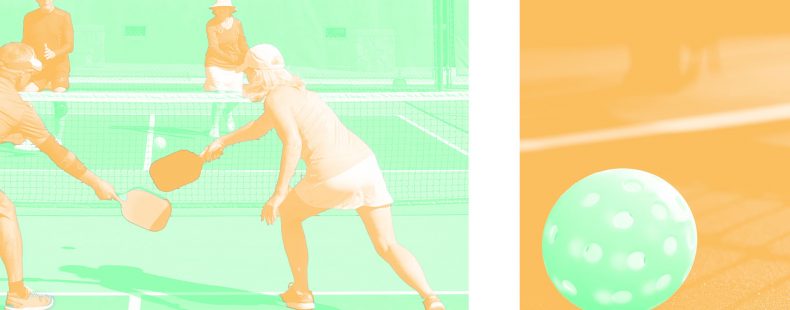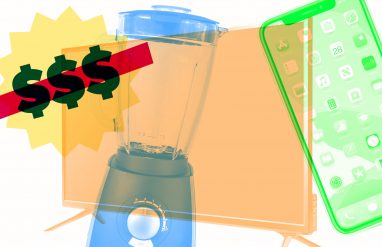If you haven’t heard, the sport of pickleball is kind of a big dill (see what we did there?) and many athletes relish the chance to play this fun game. If you’re unfamiliar with the game or have never even heard of it before, you’re likely to be confused by some of the unique lingo used by players. Needless to say, this is quite the tricky pickle to find yourself in.
That’s our cue-cumber to come to the rescue!
We’ve gathered up as many pickleball terms as we could find to come to your aid. These terms include names for parts of the pickleball court, common terms for different shots, and some fun slang terms that pickleball players like to throw around. After looking it over, you’ll have all of the pickleball knowledge you need to watch or play a game without it being too jarring!
What is pickleball?
Pickleball is a sport that in many ways resembles tennis and badminton, but it has different rules and equipment that generally make it more accessible to play. It is played indoors or outdoors on a court with a low net, using a short-handled, lightweight paddle and a perforated plastic ball. Pickleball can be played one-vs-one or two-vs-two.
Pickleball was invented in 1965 by Congressman Joel Pritchard and businessman Bill Bell. The sport was dubbed pickleball by Pritchard’s wife, Joan, because it combined parts of other games and reminded her of “pickle boats,” whose crews were often cobbled together by leftover oarsmen of other vessels. The first game of pickleball was played with a Wiffle ball, table tennis paddles, and badminton equipment.
The kitchen and other parts of the court
the kitchen
The kitchen, officially known as the non-volley zone, is the space within seven feet of the net on both sides of the court. The main rule is that a player cannot hit the ball in mid-air if they are touching any part of the kitchen.
kitchen line
Also known as the non-volley line, this line indicates where the end of the kitchen is.
centerline
The line that divides each of the two sides of the court into two.
baseline
The line at the back of the court.
backcourt
The part of the court near the baseline.
transition zone
The area of the court in between the baseline and the kitchen line.
no man’s land
A nickname for the transition zone. The transition zone is often considered the hardest part of the court to play in, so most players try to avoid having to be in it if possible.
The pickler and more basics
pickler
A pickleball player. It may be used to specifically mean a person really likes playing pickleball.
singles
A one-on-one game of pickleball.
doubles
A two-versus-two game of pickleball.
ball
A pickleball ball resembles a Wiffle ball. It is a plastic ball with round holes.
paddle
A pickleball paddle looks like a larger version of a ping pong paddle. The paddle is typically made out of graphite, fiberglass, or wood.
serve
The first hit of a pickleball during a chance to earn a point. Only the person/team performing the serve can score a point.
What’s the “dill” with cucumbers anyway? Are they fruits or vegetables? Learn the differences!
Ace, volley, and other shots
ace
A serve that is not successfully returned, which scores the server a point. Many of the more general shots in pickleball are similar or nearly the same as tennis.
volley
Hitting the ball in mid-air before it can bounce on the ground.
smash
Hitting the ball really hard in mid-air with a downward trajectory. A smash cannot hit the net or it will be a fault.
drop shot
A hit from the backcourt that lands in or near the opposing kitchen.
drive or drive shot
A low, powerful shot used to pressure an opponent.
lob or lob shot
A deep hit that goes high in the air.
poach or poach shot
A shot performed in a doubles game where a partner crosses over to their partner’s side of the court to hit the ball. They’ve poached, or stolen the ball, from their partner.
around-the-post (ATP) shot
A rare and difficult shot that travels around the outside of the post holding up the net. There is no rule regarding height of such a shot, so this shot can be below the height of the net.
body shot
A shot that hits an opponent’s body, which scores a point. While trying to hit an opponent is within the rules of the game, intentionally trying to hit a player’s face or head is strongly looked down on.
carry
A shot where the ball slides along the paddle after being hit rather than bounce on the ground. A carry is not allowed and is considered a fault according to the rules of pickleball.
“Stacking” in pickleball and more slang
stacking
An advanced formation strategy in doubles. When stacking, both teammates begin the serve on the same side of the court and then shift into their desired side after the serve is performed or returned. Stacking allows a player to stay on their preferred side of the court during the entire game of pickleball while still obeying the serving and returning rules. Without stacking, a player would normally alternate which side of the court they are playing on. Stacking is a legal strategy because a player is only required to be in a certain position on the court during the initial serve and return.
Bert and Erne
An Erne is a volley shot made over the kitchen or out of bounds next to the kitchen—and to be clear, your feet cannot be in the kitchen when this occurs. A Bert is a poach shot where a player performs an Erne on their partner’s side of the court. The Erne shot is named after pickleball player Erne Perry, who popularized the shot. The name of the Bert shot comes from combining it with Erne to form a pun reference to the Muppets Bert and Ernie from Sesame Street.
falafel
A soft shot that was unintentionally performed by hitting the ball with less power than intended.
banger
A player that likes to hit drives. This player often makes a lot of noise as they hit the ball as hard as they can.
scorpion
An overhand shot performed while squatting low. (It supposedly resembles a scorpion attacking with its tail over its body.)
flapjack
A shot that must bounce once before it can be hit. Typically, this refers to the first two shots after the initial serve, which must bounce before they can be hit.
Nasty Nelson
A serve where the server intentionally tries to hit the partner of the designated returner in a doubles game. The non-returner is not allowed to return the serve, so this would earn a point. This shot is named for pickleball player Timothy Nelson, who “popularized” this shot as part of his game.
tweener
A trick shot where a player hits the ball between their own legs.
sandbagging
Pretending to be less skilled than a player actually is. Often used to refer to a player entering a tournament intended for players below their skill level.
pickled
To lose a game of pickleball without scoring any points. The game ends 11-0.














